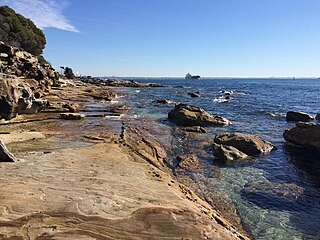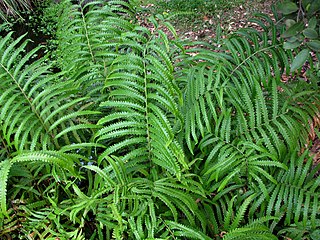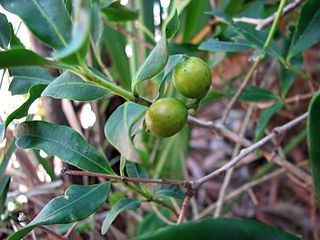
Joseph Banks, 1st Baronet, was an English naturalist, botanist, and patron of the natural sciences.

The Kamay Botany Bay National Park is a heritage-listed protected national park that is located in the eastern part of Botany Bay in Sydney, New South Wales, Australia. The 456-hectare (1,130-acre) national park is situated approximately 16 kilometres (9.9 mi) south-east of the Sydney central business district, on the northern and southern headlands of Botany Bay. The northern headland is at La Perouse and the southern headland is at Kurnell.

Daniel Carlsson Solander or Daniel Charles Solander was a Swedish naturalist and an apostle of Carl Linnaeus. Solander was the first university-educated scientist to set foot on Australian soil.

Kurnell is a suburb in Sydney, in the state of New South Wales, Australia. It is 21.4 kilometres (13.3 mi) south of the Sydney central business district, in the local government area of the Sutherland Shire along the east coast. Cronulla and Woolooware are the only adjacent suburbs. La Perouse is located opposite, on the northern headland of Botany Bay. The Cronulla sand dunes are on the south eastern headland of Botany Bay. The eastern side of the peninsula is part of Botany Bay National Park, and Towra Point Nature Reserve is located on the western side of the suburb.

Banksia robur, commonly known as swamp banksia, or less commonly broad-leaved banksia, grows in sand or peaty sand in coastal areas from Cooktown in north Queensland to the Illawarra region on the New South Wales south coast. It is often found in areas which are seasonally inundated.

As with other flowering plants, the taxonomy of Banksia has traditionally been based on anatomical and morphological properties of the Banksia flower, fruiting structure and seed, along with secondary characteristics such as leaf structure and growth habit. Increasingly, molecular evidence from DNA is providing important new insights into relationships within the genus and between this and other genera in the Proteaceae.

Microseris scapigera is a yellow-flowered daisy, a perennial herb, found in New Zealand and Australia. It is the only New Zealand species of Microseris, and one of three Australian species along with Microseris lanceolata and Microseris walteri. It is classified in a group of plants, the tribe Cichorieae, that includes chicory and dandelion.
Herman Diedrich Spöring Jr. (1733–1771) was a Finnish explorer, draughtsman, botanist and a naturalist.

Banksia integrifolia subsp. integrifolia is a subspecies of Banksia integrifolia.

The National Herbarium of Victoria is one of Australia's earliest herbaria and the oldest scientific institution in Victoria. Its 1.5 million specimens of preserved plants, fungi and algae—collectively known as the State Botanical Collection of Victoria—comprise the largest herbarium collection in Australia and Oceania.

Lambertia formosa, commonly known as mountain devil, is a shrub of the family Proteaceae, endemic to New South Wales, Australia. First described in 1798 by English botanist James Edward Smith, it is the type species of the small genus Lambertia. It is generally found in heathland or open forest, growing in sandstone-based soils. It grows as a multistemmed shrub to around 2 m (7 ft) with a woody base known as a lignotuber, from which it regrows after bushfire. It has stiff narrow leaves, and the pink to red flowerheads, made up of seven individual tubular flowers, generally appear in spring and summer. It gains its common name from the horned woody follicles, which were used to make small devil-figures.

Gleichenia dicarpa, commonly known as pouched coral fern or tangle fern, is a small fern of the family Gleicheniaceae found in eastern Australia, New Caledonia and New Zealand. It forms tangled thickets in wet places such as swamps and riverbanks.

Cyclosorus interruptus, the Hottentot fern or swamp shield-fern, is a fern in the family Thelypteridaceae. It is native to the tropics and subtropics in many parts of the world. In the New World, it is found from Mexico to Argentina, and in the Antilles. In the Old World, it is found in India, China, Malaysia, Sri Lanka and South Africa. It is also found in Australia, New Zealand, Hawaii and other islands in the Pacific Ocean. The various populations differ with respect to genetic cytotypes, glands, pubescence, and frond size. Its habitat is the vicinity of freshwater swamps and it may reach 1 m in height.

Lobelia dentata is a herb found in eastern Australia. The habitat is eucalyptus woodland and forest, often on sandy soils. It is an uncommon species, but may be locally abundant after bushfires.

Monotoca elliptica, the tree broom heath, is a plant in the family Ericaceae, found in south-eastern Australia.

Alyxia spicata, commonly known as chain fruit, is a sprawling shrub or vine in the family Apocynaceae. It is native to New Guinea and the Australian tropics.

The National Herbarium of New South Wales was established in 1853. The Herbarium has a collection of more than 1.4 million plant specimens, making it the second largest collection of pressed, dried plant specimens in Australia, including scientific and historically significant collections and samples of Australian flora gathered by Joseph Banks and Daniel Solander during the voyage of HMS Endeavour in 1770.

Persicaria decipiens, commonly known as slender knotweed, is a species of flowering plant native to Australia and Asia.

Telmatoblechnum is a genus of ferns in the family Blechnaceae, subfamily Stenochlaenoideae.

Silver Beach is a 2.8 km (1.7 mi) long west-trending sand spit in Kurnell, Sydney, New South Wales, Australia that is located 18 km (11 mi) south of the Sydney CBD. Situated on the northwestern reaches of the Kurnell Peninsula and linked with the sandstone of Sutherland Point in the east, the beach is characterised by silver-coloured sands, hence the name, and fourteen rockwall groynes which project into Botany Bay. The eastern point of the beach is the site where Captain James Cook first set foot on Australian soil in 1770, which marked the beginning of Britain's interest in Australia and in the eventual colonisation of this new "southern continent".



















